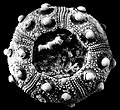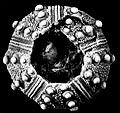The Echinoid Directory
Levicidaris Kier, 1977, p. 21
| Diagnostic Features |
|
|---|---|
| Distribution | Late Triassic (Carnian); Italy. |
| Name gender | feminine |
| Type | Levicidaris zardini Kier, 1977, p. 21, by original designation. |
| Species Included |
|
| Classification and/or Status |
|
| Remarks |
|




